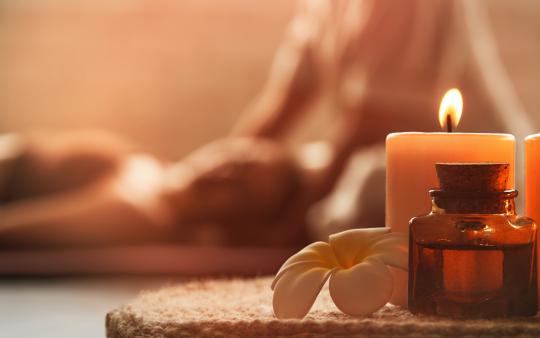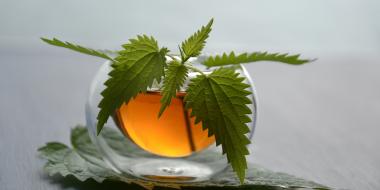Ayurveda is an ancient South Asian system of healing which has been practiced in India for thousands of years. From Sanskrit, ayu (life), and veda (wisdom), Ayurveda is often translated as the knowledge or science of life. The medicine is vast and varied, but throughout its nature-based teachings, emphasis is placed on self-awareness and self-care. Practices that one can do at home are often encouraged for radiant health and longevity, and include nutritional guidelines, breathing exercises, meditation, yoga, and warm oil massage.
Ayurveda highlights the value of touch for all ages and stages of life. Loving touch using medicinal plant oils can provide inner calm, strengthen the body, and even delay age-related skin changes. We now see that modern science confirms the benefits of touch to lower cortisol levels, activate oxytocin (also known as the love hormone), and invite a sense of physical and emotional safety. Certainly, self-touch can nurture self-awareness and healing.
In the Ayurvedic tradition, a warm oil massage is referred to as abhyanga, as it works with both the physical and energetic body. This treatment can be received by two hands or four (sometimes two practitioners will offer a session), or it can done by yourself. Self-abhyanga can be a satisfying experience. I recommend self-abhyanga to clients who wish to commit to routine self-care, whether it’s daily, weekly or monthly massages.
Many years ago, when I first heard of self-massage being performed on a regular basis, I assumed this was too time-consuming for most people. I wondered about body mobility, and how this may be challenging for anyone who suffers chronic pain. Once I started to give myself daily abhyanga however, I began to understand that modifying the massage based on how you are feeling is a powerful tool for self-awareness, along with the massage itself. For example, take time before you begin to assess where your body might need extra love and attention. Likewise, if it’s too challenging to massage your whole body, you could massage just your feet, hands, or face. While you are massaging, you can also check in with your body, noting how you feel and if there are changes to your skin. What a great way to honour yourself!
The Benefits of Self-Abhyanga
There are many obvious advantages to self-abhyanga such as mitigating stress and creating pain relief, and other documented benefits include:
- Strengthening immunity and longevity
- Promoting deeper sleep
- Protecting skin prone to eczema
- Nourishing dry skin
- Improving eyesight
- Encouraging sturdiness and strength of muscles and organs
- Improving digestion and detoxification
- Encouraging the smooth flow of prana, also known as life force energy
- Promoting self-awareness
Oils for Ayurvedic Massage
Ayurvedic medicine is individualized depending on the dosha, the health condition of the patient. Oils for massage are often selected and medicated based on patient-specific criteria. A commonly used oil which is tri-doshic, or for all constitutions and all seasons, is cold-pressed sesame seed oil. If you are sensitive to nuts or seeds, you may try jojoba oil. Almond oil is vata (air dosha), pacifying and great in fall and winter. Mustard seed oil is kapha (earth dosha), pacifying and lovely as a warming oil during cold winter months. Coconut oil is pitta (fire dosha), pacifying and welcomed during hotter months as a way to cool down the body. Within Ayurveda, the oil is a central part of the massage. By applying it to the body, it helps balance an individual’s dosha or elemental makeup.
The Sanskrit term for oil application is snehana, which translates to loving affection. When doing abhyanga we can think of the oil as an extra dose of nourishment and care for our system, so choose oils wisely. Aim for edible oils, organic when possible, and avoid those that are perfumed, rancid, or mineral-based.

How to Perform a Warm Oil Massage
- Place a glass vessel or steel cup of oil in a bowl of hot water, until its pleasantly warm. Avoid heating the oil directly as this will changes its properties.
- Sit or stand comfortably on a towel in a draft-free, warm room.
- Take a couple of deep breaths and pay attention to where your patient needs extra care. Hold the oil in your hands for a few moments, and begin by massaging one of three energy centres: the top of head, heart, and navel.
- Using the palm of your hand, massage the oil onto your patients' entire body, starting at the extremities and working towards your heart. Use long strokes on the limbs and circular strokes on the joints. Massage the abdomen in clockwise, circular motions, following the path of the large intestine; moving up on the right side of the abdomen, then across, and then down on the left side.
- Give extra time to massage the scalp, ears, and feet. When applying oil to the crown of the head, work slowly out from the centre in circular strokes.
Helpful Advice Related To Ayurvedic Massage
- If you personally are experiencing chronic pain or a mobility issues, consider administering self-massages to important energy centers such as the hands, feet, abdomen, or chest, depending on what's accessible within your mobility.
- Traditionally abhyanga is performed before bathing as the hot water can help penetrate the oil into the skin. If choosing to perform before a shower, wipe your feet before stepping into the tub, and be careful not to slip! Alternatively, massage after a bath, or before going to sleep can be wonderful and also effective.
- Use a towel you don’t mind getting oily. It is likely to be soaked in oil after the massage
- Take your sensual time and luxuriate in this moment for yourself
Contraindications
Do not perform abhyanga during menstruation, the first trimester of pregnancy, during fever or acute illness, or attempt a warm oil massage on skin with open wounds or rashes.









